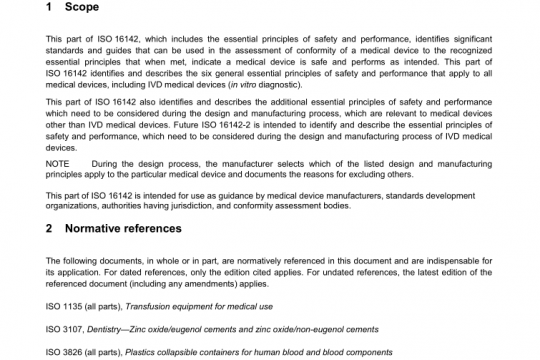AAMI TIR25 pdf free download
AAMI TIR25 pdf free download.Chemical indicators- Guidance for the selection, use, and interpretation of results.
4 General considerations
Chemical indicators are designed to change when preset critical parameters have been delivered. They have not been designed to show the causes of the failure when intended changes do not occur. It is up to the user to determine the cause or causes of the chemical indicator failure. The information provided by a chemical indicator is revealed by means of the occurrence, or nonoccurrence, of a characteristic physical or chemical change that is observable by the user. A number of different classes of chemical indicators have been developed to suit different monitoring needs and to accommodate varying ideas of what is the most useful information about any given sterilization process. Some types of chemical indicators are sensitive to certain specific problems, such as a temperature deficiency, while others may be less sensitive to an individual parameter but may simultaneously test the overall process condition. This document addresses the following classes of chemical indicators identified in
ANSI/AAMI ST6O:
— Class 1—Process indicators
— Class 2—Indicators for use in specific tests
— Class 3—Single parameter indicators
— Class 4—Multiparameter indicators
— Class 5—Integrating indicators
This classification is based on defined general performance characteristics across several different sterilization processes (per ST6O) rather than on chemical or physical changes that are related to any one specific sterilization process.
The basic performance descriptor of any chemical indicator is its endpoint response, which is the observable change after exposure to certain predefined physical conditions. The manufacturer specifies the endpoint for the chemical indicator. The conditions that yield the endpoint response are the basis for the classes of chemical indicators that have been described. The availability of a wide variety of products and claims has led to confusion in the user community about the proper use and interpretation of the chemical indicators’ results. The concern stems from a lack of understanding about what the various types of chemical indicators are designed to do and what they show. For example, in a steam sterilization process, some chemical indicators need to be exposed to steam for a minimum length of time to achieve the endpoint; some need to be exposed to a minimum temperature; some are affected by a combination of time and temperature of exposure; and still others are affected by time, temperature, and presence of saturated steam. In all cases, the user compares the response of the chemical indicator to an endpoint that is described by the manufacturer. If the endpoint for the chemical indicator was not met, then the preset cycle parameters were not delivered. The user should investigate possible causes for the failure of the chemical indicator to change (e.g., incorrect choice of packaging, improper packaging or loading technique, sterilizer malfunction, etc.).If the use of the chemical indicator is limited to a specific sterilization cycle, this information should be stated or coded on the product. For example, “steam 15 mm 121° C” means that the indicator is intended for use in a 15 minute, 121° C steam sterilization cycle.
Questions regarding the selection of the basic types of chemical indicators that are best suited to a particular application can be answered only in the context of the specific sterilization process to be monitored, the possible problems that prevent sterilization, the performance characteristics of each class of chemical indicator, and the things that constitute an effective sterility assurance program. Once a chemical indicator is selected, its value in the sterility assurance program depends on its correct use, correct interpretation of endpoint response, and compliance with the protocols that were established for unacceptable results.AAMI TIR25 pdf download.
Other IEC Standards
-

ANSI AAMI ISO 16142-1 pdf free download – non-IVD medical devices and guidance on the selection of standards
AAMI standards list DOWNLOAD -

ANSI AAMI ISO 16142-2 pdf free download – General essential principles and additional specifc essential principles
AAMI standards list DOWNLOAD


